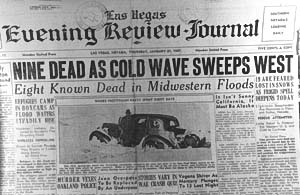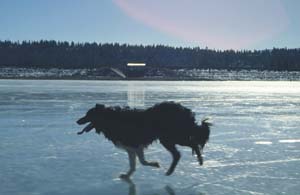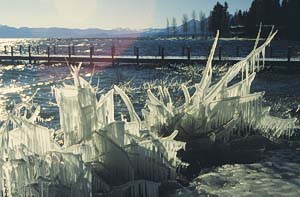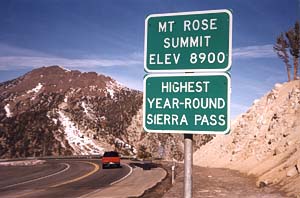 |
|
|||||||||||||||||||||||||
|
Follow Mark on Facebook for more stories |
|||||||||||||||||||||||||
|
Nevada's Hottest Month: July 1931. Records that still stand include 118º at Las Vegas, 108º at Winnemucca and Minden, and 105º at Austin. Unofficially the mercury rose to 131º at the construction site of the Boulder Dam during this extreme heat wave.*
*U.S. official record high temperature is 134º at Death Valley, California, recorded on July 10, 1913. Nevada's Coldest Month: Tie between January 1937 & December 1990 Old timers may remember 1937, the chilliest month in Nevada's history. (The coldest winter season was 1948-49.) In fact, two separate cold waves in Jan. 1937 kept the Silver State in the deep freeze and set many all-time record low temperatures for Nevada and California that still stand. The U.S. Climatological Data report says it all: "January 1937 was the coldest month for the State as a whole since records were kept. New low temperatures were established at many stations in the northern and western portions of the State.
The brutal cold wave of 1937 began when a frigid air mass rolled into the Great Basin during the first week of January, which sent the mercury plummeting until minus 50º set a new State record at San Jacinto in Elko County on the 8th. (The previous record of 45º below zero — set on December 19, 1924 — also occurred at San Jacinto, a mile-high basin located near the Idaho border.) Reno plunged to minus 16º in Jan. 1937, just three degrees shy of the city's record low of –19º set in January 1890. A second Arctic intrusion bulldozed into the region 10 days later and reinforced the frigid air already entrenched in the Intermountain West. On January 20, 1937, weather observers at Boca, California noted a thermometer reading 45º below zero, the Golden State's all-time lowest recorded temperature. Overnight temperatures in eastern Nevada were in the deadly subzero range, minus 30ºs and 40ºs during January 1937, but in the usually milder western valleys conditions were only slightly better. Downtown Reno plunged to –16º on January 8, exactly 47 years to the day of the city's all-time record low, set on January 8, 1890. Far to the south in Las Vegas, gamblers were chilled to the bone when the thermometer dropped to 10º on January 22. For the State as a whole that month, the mean temperature was only 13.5º, nearly 16 degrees below the average for the previous 49 years. Las Vegas reported the highest monthly mean temperature
December 1990 was one of the coldest months since records were first kept in the Silver State more than a century ago. In fact, it shares the podium with the coldest month of all, January 1937. The other winners in the "Top Ten" coldest months include January 1890, January 1913, January 1917, December 1924, December 1932, January 1949, December 1972, and February 1989. During the brutal cold snap of December 1990, at least 16 locations, with between 30 and 113 years of record, set new low temperatures for any month, with 2 to 3 times that many just missing all-time lows but establishing new minima for December. The State's long-standing December low of minus 45º, set in 1924 in San Jacinto was broken, as minus 46º was recorded at Mountain City during the peak of the pre-Christmas cold snap. (The – 46º at Mountain City ranks second only to the minus 50º set in January 1937 as Nevada's all-time lowest temperature.)
The 1990 Arctic intrusion plunged deep into Nevada; Boulder City dropped to 9º, exceeding the 1937 record by 2º. Carson City registered a minus 19º and Reno recorded a minimum of 13º below zero. The coldest air during this event settled in over the central and eastern portions of the Silver State where many observers reported all-time record lows for ANY month with temperatures below minus 40º in several locations, but residents and visitors in western Nevada also shivered during this severe cold wave. In the Sierra only the bravest skiers and boarders ventured out to the slopes where frostbite warnings were posted; on Slide Mountain the wind chill registered 52º below zero. Other Sierra stations reported brutally cold readings; South Lake Tahoe fell to 17º below zero; Markleeville 25º below; and Truckee hit minus 28º. All-Time Minimum Temperatures for Any Month set in December 1990
|
|||||||||||||||||||||||||||||||||||||||||||||||||||||||||||||||||||||||||||||||||||||||||||||||||||||||||
|
Much of the Nevada weather data posted here was previously published in the Nevada Climate Summary, a monthly review issued by John W. James, State Climatologist. Nevada Climate Summaries are available at Nevada libraries. More information may be obtained by email. |
|||||||||||||||||||||||||||||||||||||||||||||||||||||||||||||||||||||||||||||||||||||||||||||||||||||||||
|




